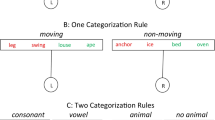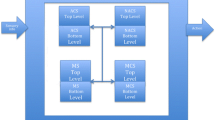Abstract
Emotions are inextricably interwoven with cognitions. To the extent that we are willing to be informed by introspections, it is clear that emotions pervade our conscious life, and that there are emotional aspects to most kinds of mental activity. Consequently, the relation of emotion to cognition has been a central matter of speculation for theorists of emotion. Yet if we demand more rigorous evidence, surprisingly little can be said. One of the promises of the emerging cognitive science is that it provides conceptual tools that may allow progress beyond introspectively inspired speculation to a stage of theory-driven empirical research on emotion and cognition. The task is to delineate the mechanisms defining the interface between these two processes. What roles do cognitive mechanisms play in emotions and which effects do emotions have on cognitions? The purpose of the present chapter is to address one issue in this general context, namely the nature of the cognitive mechanisms that underlie the evoking of emotions. However, before this central question is addressed, it is necessary to digress briefly to describe the perspective on emotion upon which our research is based.
Access this chapter
Tax calculation will be finalised at checkout
Purchases are for personal use only
Preview
Unable to display preview. Download preview PDF.
Similar content being viewed by others
References
Balota, D.A. (1983). Automatic semantic activation and episodic memory encoding. Journal of Verbal Learning and Verbal Behavior, 22, 88–104.
Bowers, K.S. (1984). On being unconsciously influenced and informed. In K.S. Bowers & D. Meichenbaum (Eds.), The unconscious reconsidered (pp. 227–272). New York: Wiley.
Bowlby, J. (1969). Attachment and loss: vol 1. Attachment. London: Hogarth Press.
Chevalier-Skolnikoff, S. (1973). Facial expression of emotion in nonhuman primates. In P. Ekman (Ed.), Darwin and facial expression (pp. 11–89). New York: Academic Press.
Cheesman, J., & Merikle, P.M. (1984). Priming with and without awareness. Perception and Psychophysics, 36, 387–395.
Cheesman, J., & Merikle, P.M. (1986). Distinguishing conscious from unconscious perceptual processes. Canadian Journal of Psychology, 40, 343–367.
Darwin, C. (1872). The expression of emotion in man and animals. London: Murray.
Dimberg, U. (1986). Facial expression as excitatory and inhibitory stimuli for conditioned autonomic responses. Biological Psychology, 22, 37–57.
Dixon, N.F. (1981). Preconscious processing. Chichester: Wiley.
Eibl-Eibesfeldt, I. (1980). Strategies of social interaction. In R. Plutchik & H. Kellerman (Eds.), Emotion: Theory, research, and experience (pp. 57–80). Vol. 1. New York: Academic Press.
Ekman, P. (1972). Universals and cultural differences in facial expressions of emotion. In J.K. Cole (Ed.), Nebraska symposium on motivation (pp. 207–212). Vol. 19. Lincoln: University of Nebraska Press.
Ekman, P., & Friesen, W. (1976). Pictures of facial affect. Palo Alto: Consulting Psychologists Press.
Erdelyi, M.H. (1974). A new look at The New Look: Perceptual defense and vigilance. Psychological Review, 81, 1–25.
Eriksen, C.W. (1960). Discrimination and learning without awareness. Psychological Review. 67, 279–300.
Folkman, S., Schaeffer, C., & Lazarus, R.S. (1979). Cognitive processes as mediators of stress and coping. In V. Hamilton and D.M. Warburton (Eds.), Human stress and cognition: An information processing approach (pp. 265–298). Chichester: Wiley.
Fowler, C.A., Wolford, G., Slade, R., & Tassinary, L. (1981). Lexical access with and without awareness. Journal of Experimental Psychology: General, 110, 341–362.
Hamburg, D.A., Hamburg, B.A., & Barchas, J.D. (1975). Anger and depression in perspective of behavioral biology. In L. Levi (Ed.), Emotions: Their parameters and measurement (pp. 235–278). New York: Raven Press.
Hasher, L., & Zacks, R.T. (1979). Automatic and effortful processes in memory. Journal of Experimental Psychology: General, 108, 356–388.
Holender, D. (1986). Semantic activation without conscious identification in dichotic listening, parafoveal vision, and visual masking: A survey and appraisal. Behavioral and Brain Sciences, 9, 1–66.
Izard, C.E. (1979). Emotions as motivations: An evolutionary-developmental perspective. In H.E. Howe & R.A. Dienstbier (Eds.), Nebraska symposium on motivation (pp. 163–200). Lincoln: University of Nebraska Press.
Klein, D.F. (1981). Anxiety reconceptualized. In D.F. Klein & J. Rabkin (Eds.), Anxiety: New research and changing concepts (pp. 235–263). New York. Raven Press.
Lang, P.J. (1968). Fear reduction and fear behavior: Problems in treating a construct. In J.M. Shlien (Ed.), Research in psychotherapy (pp. 90–102). Vol III. Washington, DC: American Psychological Association.
Lazarus, R.S., Averill, J.R., & Opton, E.M., Jr. (1970). Toward a cognitive theory of emotion. In M. Arnold (Ed.), Feelings and emotions (pp. 207–231). New York: Academic Press.
Leventhal, H., & Scherer, K. (1987). The relationship of emotion to cognition: A functional approach to a semantic controversy. Cognition and Emotion, 1, 3–28.
McCauley, C., Parmelee, C.M., Sperber, C.D., & Carr, T.H. (1980). Early extraction of meaning from pictures and its relation to conscious identification. Journal of Experimental Psychology: Human Perception and Performance, 6, 265–276.
McNally, R.J. (1987). Perparedness and phobias: A review. Psychological Bulletin, 101, 283–303.
MacLeod, C., Mathews, A., & Tata, P. (1986). Attentional bias in emotional disorders. Journal of Abnormal Psychology, 95, 15–20.
Mandler, G. (1975). Mind and emotion. New York: Wiley.
Mandler, G. (1984). Mind and body: The psychology of emotion and stress. New York: W.W. Norton.
Marcel, A.J. (1983a). Conscious and unconscious perception: An approach to the relations between phenomenal experience and perceptual processes. Cognitive Psychology, 15, 238–300.
Marcel, A.J. (1983b). Conscious and unconscious perception: Experiments on visual masking and word recognition. Cognitive Psychology, 15, 197–237.
Mathews, A., & MacLeod, C. (1985). Selective processing of threat cues in anxiety states. Behaviour Research and Therapy, 23, 563–569.
Mathews, A., & MacLeod, C. (1986). Discrimination of threat cues without awareness in anxiety states. Journal of Abnormal Psychology, 95, 131–138.
Mayr, E. (1974). Behavior programs and evolutionary strategies. American Scientist, 62, 650–659.
Öhman, A. (1979). The orienting response, attention, and learning: An information processing perspective. In H.D. Kimmel, E.H. van Olst, & J.F. Orlebeke (Eds.), The orienting reflex in humans (pp. 443–472). Hillsdale, NJ: Erlbaum.
Öhman, A. (1986). Face the beast and fear the face: Animal and social fears as prototypes for evolutionary analyses of emotion. Psychophysiology, 23, 123–145.
Öhman, A. (1987). Evolution, learning and phobias: An interactional analysis. In D. Magnusson & A. Öhman (Eds.), Psychopathology: An interactional perspective (pp. 143–158). Orlando, FL: Academic Press.
Öhman, A. (in press). The psychophysiology of emotion: An evolutionary-cognitive perspective: In P.K. Ackles, J.R. Jennings, & M.G.H. Coles (Eds.), Advances in psychophysiology. Vol. 2. Greewich, CT: JAI Press.
Öhman, A., & Dimberg, U. (1978). Facial expressions as conditioned stimuli for electrodermal responses: A case of “preparedness”? Journal of Personality and Social Psychology, 36, 1251–1258.
Öhman, A., & Dimberg, U. (1984). An evolutionary perspective on human social behavior. In W.M. Waid (Ed.), Sociophysiology (pp. 47–86). New York: Springer-Verlag.
Öhman, A., Dimberg, U., & Öst, L.-G. (1985). Animal and social phobias: Biological constraints on learned fear responses. In S. Reiss & R.R. Bootzin (Eds.), Theoretical issues in behavior therapy (pp. 123–178). New York: Academic Press.
Panksepp, J. (1982). Toward a general psychobiological theory of emotions. Behavioral and Brain Sciences, 5, 407–422.
Posner, M.I. (1978). Chronometric explorations of mind. Hillsdale, NJ: Erlbaum.
Purcell, D.G., Stewart, A.L., & Stanovich, K.E. (1983). Another look at semantic priming without awareness. Perception and Psychophysics, 34, 65–71.
Schacter, D.L. (1987). Implicit memory: History and current status. Journal of Experimental Psychology: Learning, Memory, and Cognition, 13, 501–518.
Schneider, W., Dumais, S.T., & Shiffrin, R.M. (1984). Automatic and control processing and attention. In R. Parasuraman & D.R. Davies (Eds.), Varieties of attention (pp. 1–28). Orlando, FL: Academic Press.
Scott, J.P. (1980). The function of emotions in behavioral systems: A systems theory analysis. In R. Plutchik & H. Kellerman (Eds.), Emotion: Theory, research and experience (pp.35–56). Vol. 1. New York: Academic Press.
Shiffrin, R.M., & Schneider, W. (1977). Controlled and automatic human information processing: II. Perceptual learning, automatic attending, and a general theory. Psychological Review, 84, 127–190.
Shevrin, H., & Dickman, S. (1980). The psychological unconscious: A necessary assumption for all psychological theory. American Psychologist, 35, 421–434.
Zajonc, R.B. (1980). Feeling and thinking: Preferences need no inferences. American Psychologist, 35, 151–175.
Author information
Authors and Affiliations
Editor information
Editors and Affiliations
Rights and permissions
Copyright information
© 1988 Kluwer Academic Publishers
About this chapter
Cite this chapter
Öhman, A. (1988). Preattentive Processes in the Generation of Emotions. In: Hamilton, V., Bower, G.H., Frijda, N.H. (eds) Cognitive Perspectives on Emotion and Motivation. NATO ASI Series, vol 44. Springer, Dordrecht. https://doi.org/10.1007/978-94-009-2792-6_5
Download citation
DOI: https://doi.org/10.1007/978-94-009-2792-6_5
Publisher Name: Springer, Dordrecht
Print ISBN: 978-94-010-7756-9
Online ISBN: 978-94-009-2792-6
eBook Packages: Springer Book Archive




